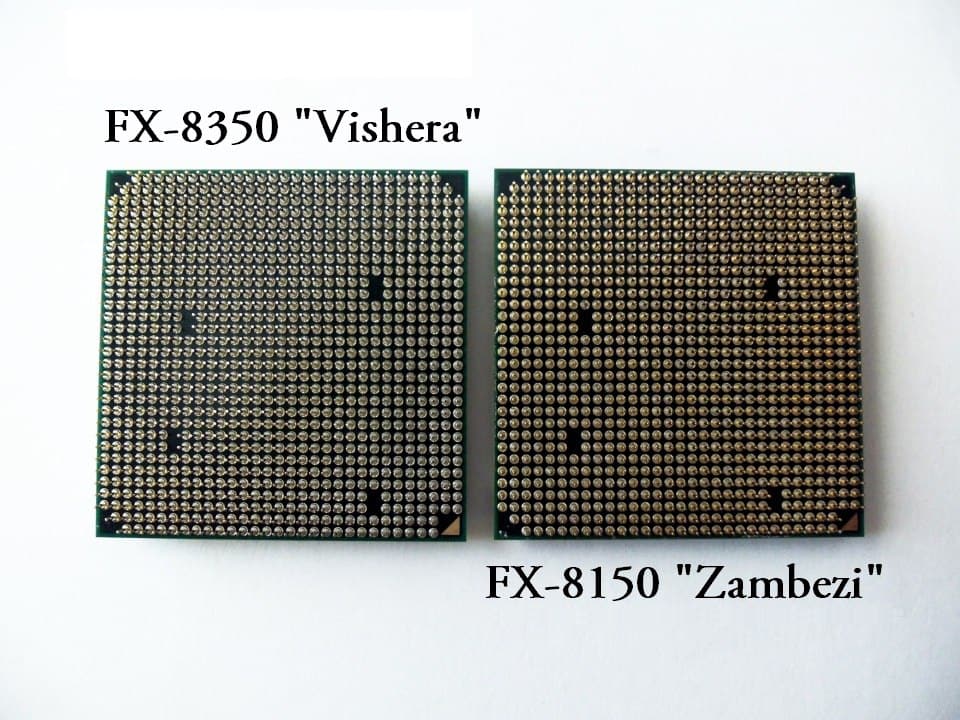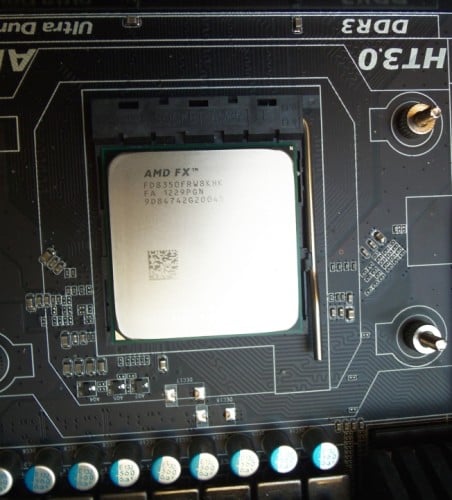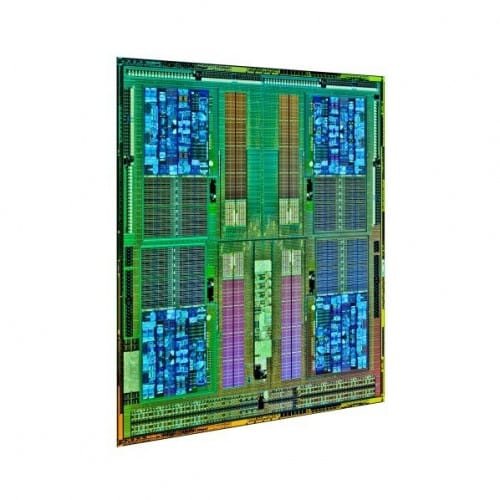We have all seen a glimpse into what the new AMD Piledriver architecture is capable of with our recent review of the Virgo Platform and Trinity APUs. This time around the graphics processor is out and the massive shared L3 cache is in as the only area not improved upon in this latest revision. Vishera is AMD’s proving ground to make or break their new approach to CPU design. After having some time with the new flagship processor, the FX-8350, I’ve learned some things about this new processor. I know you want to know if AMD is taking the right path so let’s get right to it!
Feature and Specification Highlights
The Trinity APUs were shifting to the AMD module design making the existence of the Piledriver architecture the updated feature. The FX-8350 is an update to the existing module design of Bulldozer which is why it is referred to as Enhanced Bulldozer. We will start right there and take a closer look at what makes Piledriver different.
As you can see there are a number of improvements across the board at the module level. There are improvements to the instruction sets with FMA3 and F16C ISA extensions, branch predictions, scheduling, L1 cache, hardware pre-fetcher, L2 cache responsiveness, and instruction execution. I do not have the Engineering expertise to explain what all that means individually, but I can at least simplify it for you: AMD has improved how fast the processors calculates, loads, and executes instructions.
Beyond the laundry list of improvements, the new Vishera CPUs are the same overall design you have with any AMD FX-series processor. In direct comparisons you will also notice an increase in default core speed moving from the Zambezi chips.
Vishera will launch as a family of four with a lower end 8 core (FX-8320), a 6 core (FX-6300) and a quad core (FX-4300) with accompanying drops in price from the top. The new flagship AMD FX-8350 at 4.0 GHz (4.2 GHz Max Turbo) will be priced at $199 MSRP. This puts the FX-8350 priced well below the initial release of the FX-8150.
But does the lower cost signal to anything other than a more competitive price? Let’s move on to testing to see if that is a factor or not.
Testing System
Our test system setup is very similar to the one we ran when we first reviewed the AMD’s first Bulldozer CPU about the same time last year. This should give us a good idea of just how far things have come with the new hardware.
Hardware:
- CPU: AMD FX-8350 “Vishera” 4.0 GHz (4.2 GHz Max Turbo) & AMD FX-8150 “Zambezi” 3.6 GHz (4.2 GHz Max Turbo)
- CPU Cooler: Noctua NH-D14
- Motherboard: GIGABYTE 990FXA-UD7 AM3+
- Memory: G.Skill RipjawX 2133 MHz (9-11-10-28) @ 1866 MHz (9-10-9-27)
- Graphics Card: AMD Radeon HD 6850 1GB Reference Card
- PSU: Antec HCP 850 Watt 80+ Gold
- SSD: Patriot Pyro SATA III MLC 60 GB (Sandforce 2281 controller)
- HDD: Seagate Barracuda XT 2 TB
- Case: Rosewill Thor V2
Software:
- Windows 7 64-bit Ultimate
- CCC 12.8
- AMD Overdrive 4.2.3
- PCMark07
- 3DMark11
- SiSoft Sandra 2012 SP5c
- wPrime
- 7-Zip
- Handbrake 0.9.8
- Alien Vs. Predator DX11 Benchmark
- Resident Evil 5 DX10 Benchmark
- Metro 2033
- Battlefield 3
- OCCT 3.1
- FurMark 1.9.1
Installation and Upgrade Notes
The only thing you need to take notice of when installing is that the AMD Vishera line are AM3+ processors. That means that unless your board supports an AM3+ CPU, you will not be able to upgrade. Although certain 890Fx boards did pledge support for Bulldozer, the waters get muddier with Vishera.
You may want to check with your motherboard manufacturer for recent BIOS updates to ensure 100% compatibility, but these CPUs are drop in upgrades for the most part with any AM3+ motherboard. I will be using the exact same test system for updating results for both the AMD FX-8150 and Phenom II 1100T CPUs and then finally, the FX=8350 “Vishera” CPU. Although I believe the FX-8350 would have worked without changing anything, even the BIOS, I did not have a chance as I had already flashed to the BIOS version 10e provided by GIGABYTE.
Overclocking Notes
The FX-8350 was a very familiar dancing partner when it came to overclocking. It was my experience that the Vishera chips had the same overclocking characteristics as the Zambezi chips. I first started my disabling all the power management systems in the BIOS to avoid voltage drops.
If you are going to overclock your FX-8350 you need to watch your voltage settings. I never had an issue with overheating, but 1.55V was too much for my chip. I reached the 4.5 GHz at 1.55V, but moving to higher clock speeds required me to lower voltage to 1.525V. This seems to the sweet spot for my particular copy of the FX-8350 silicon. Your mileage will of course vary depending on a number of factors.
As with the FX-8150, I was able to get by system to boot at 5.0 GHz. Unfortunately booting was all I could get the FX-8350 to do at that speed. Stepping back, I eventually landed at 4.6 GHz for 100% stability. I was able to play Battlefield 3 and complete several tests at up to 4.8 GHz, but I still had some intermittent crashes. I believe moving to higher end liquid cooling would be necessary to reach speeds higher than 4.6 GHz. I would personally keep my FX-8350 at 4.5 GHz for daily use based on my experience.
Now let’s get on with the benchmarks and see how the new FX does against the old FX!
Total System Performance (PCMark07)
Once again lets setup some expectation by getting overall system performance. Since I no longer have the 1100T to retest, I will not be including its results here. The FX-8150 was retested with the new BIOS and recent software updates to keep things fair.
The Vishera FX-8350 comes out ahead from 300 to 500 points when compared to the Zambezi FX-8150. Even when overclocked to 4.7 GHz, the Zambezi struggles to maintain a lead over the stock FX-8350. This performance improvement is not just clock rate. The FX-8350 has a 200 to 600 point lead when overclocked at 4.6 GHz despite being 100 MHz slower than the overclocked FX-8150.
Synthetic Graphics (3DMark11)
Now let’s get a good idea of how the FX-8350 will do in games. This is an important area for improvement as many PC enthusiasts are also gamers. There was minimal difference between the 1100T and FX-8150 in previous tests, so lets see if the Vishera CPU can pull away from the pack.
The FX-8350 leaves no room for doubt in these results by outperforming an overclocked FX-8150 while itself being at stock. It was strange to see a performance drop when the FX-8350 was up to 4.6 GHz, but did gain a bump in physics performance. This is an anomaly you often find with new products. I am sure, as with previous testing, this will be ironed out with a software update.
Real World Gaming Performance (Resident Evil 5 and Alien Vs. Predator)
Now lets take a closer look at gaming performance starting with testing across all three DirectX versions. RE5 is tested at all maxed out settings, Vsync off, motion blur off, and unlocked frame rate. AvP was tested with default DX11 settings with tessellation on and high detail. Both were tested at 1920 x 1080 resolution. I will also be including previous benchmark results from the Phenom II 1100T as a comparison only.
There is minimal to no difference in performance across all three chips. This shows that with these particular titles the graphics card is the limiting factor. I also noticed when overclocked I always got exactly 38 FPS as the result in AvP. I believe this could be a issue with the benchmark as there is also a slight drop in performance across the board from stock. Lets move onto something more graphically intense to get more detail about gaming performance.
Real World Gaming Performance (Battlefield 3 and Metro 2033)
This time we will be looking at two DX11 titles. The difference here will the time frame in which these gamers were compiled with Battlefield 3 being designed for modern graphics cards and a modern processor. While Metro 2033 is an older title well known for being extremely taxing on graphics cards.
Metro 2033 is tested with graphical settings complete maxed out. Battlefield 3 is tested with all Ultra settings, HBAO, 8x AF, no post processing, and maximum view distance. I used FRAPS at 300 second intervals with three samples taken during live game play and averaged out. Battlefield 3 was tested on a full 64 man server on Alborz Mountains.
Performance for the older Metro 2033 is virtually the same. The fluctuation in results can be attributed to differences in my gameplay though I tried to trace my steps as best as I could with each test. Battlefield 3 was a different story.
The FX-8350 clearly came out ahead by a 12 FPS average and on max FPS as well. The FX-8150 Zambezi at 4.7 GHz did manage to match the FX-8350 Vishera’s stock performance. I believe this was close to my HD 6850’s performance limit as overclocking the FX-8350 resulted in similar performance at higher clocks speeds.
General CPU Performance (Cinebench 11.5)
Lets take a good look at just the performance of the CPU itself to see if the results we have so far are just a fluke. This should clearly show if there was improvement in CPU performance with raw calculation performance. I will be including the Phenom II 1100T results for comparision only. This should allow us to weigh in on the past single-thread performance concerns with the Zambezi CPUs.
There is some good news and bad news. The Vishera FX-8350 matches single threaded performance of the Phenom II 1100T at 1.11. It is a good sign as the FX-8350 can claim its place as the undisputed champion amongst AMD processors. On the down side, it still falls behind the i7 2600k in single-threaded performance. However, the new Vishera is still much cheaper than the top end INTEL Sandy Bridge parts and even further away in price from the Ivy Bridge parts.
Multi-threaded performance is a different story with the FX-8350. It shows its teeth by coming ahead of the i7 2600k with four physical cores and four virtual ones. Overclocking also shows a nice gain in both tests with the multi-threaded performance gaining nearly a full point.
SANDRA 2012 SP5c (Arithmetic CPU Performance)
Now lets use more task specific tests to see if the FX-8350 has any weaknesses. The arithmetic tests will show how well Vishera handles Integer math in three different environments.
This is where the Zambezi chip is capable of giving some decent competition in the field. The FX-8150 even gets a win with a 1.11 advantage when both processors are overclocked. In every other test the FX-8350 takes the lead though not in any sort of spectacular fashion.
SANDRA 2012 SP5 (Cryptography Performance)
Next up will be testing where we can see if enhanced instruction sets can make a huge difference. We have to point out that the AES extension make the AES-256 testing unfair when compared to chips that do not support it. On the other hand, the first Bulldozer chips showed a loss in SHA-256 performance which turned out to be a coding issue with Sandra. This has long since been corrected and now shows more accurate results.
Once again the FX-8350 definitively pull ahead of its predecessor. Even when overclocked to 4.7 GHz, the Zambezi FX-8150 is struggling to compete with the FX-8350 at stock speeds. The Intel i7 2600k takes a firm victory in AES-256, but falls well behind in the SHA-256 testing.
SANDRA 2012 SP5 (Memory Performance)
Concluding our performance tests with SANDRA 2012 is the memory performance test. This has been an area that AMD has been playing catch up to Intel for a number of years. The Bulldozer sports a new memory controller from AMD that was original seen on the first APUs. Lets see if there is any additional performance improvement there. Results from an INTEL Core i7 2600k will also be included for comparison.
There is unfortunately no major improvement with memory bandwidth over the Bulldozer. This means there is still a 16.6% advantage for the i7 2600k at the same clock speed. This was expected as the memory controller was not listed as being changed or enhanced by AMD in any way.
Real World CPU Performance (7-zip)
This will be a real work example of the cryptography testing that we did earlier on. The 7-zip benchmark is a simple and straight forward test of how well your CPU/memory combo can handle compression and decompression. I run this test 3 times and use the best results.
The results here can be enhanced with faster memory, more threads, and/or more CPU clock speed. The 8 core/8 threaded FX-8350 with 1866 MHz RAM comes out ahead of all the competition. Once again overclocking shows improvement for all AMD processors with the Vishera coming out on top minus 100 MHz of speed given up to the Zambezi chip. The Intel i7 2600k also has a strong showing, but 7-zip continues to favor AMD.
Real World CPU Performance (Handbrake 0.9.8)
Now lets look at raw core performance with a widely used program known to favor clock speed and core count over anything else. Memory can affect the performance results, so I will include both clock rates for the i7 2600k. This test is done with a 720p H.264 video that is 5 minutes in length being converted to fit an iPhone4 in format and size.
The FX-8350 has no trouble cruising into the lead at stock speed. Even with overclocking the Zambezi FX-8150 still falls short in FPS during converting. Overclocking the FX-8350 shows there is performance to gain with higher clock speeds.
Power Consumption
Now for the final piece to the puzzle. How much power do you need to get the performance shown by the FX-8350? Ideally we would like to see a drop in power consumption with every newer generation/revision, but lets see what the numbers show.
This is the stand out improvement we were hoping for. With 20 watts less being used at idle and 30 watts less at full load, the new Vishera gets more efficient. There is obvious power consumption increase when overclocking (disabled power saving features) comes into play, but nothing unreasonable like the near 400 watt system power use by the overclocked FX-8150. There is a drop of almost 75 watts for these new Vishera processors when overclocked.
Final Thoughts
This is one of those occasions where AMD has done their job well, but we can’t really celebrate quite yet. The new flagship AMD FX-8350 “Vishera” definitively takes the title of champion amongst AMD processors. The Phenom II 1100T 6-core CPU can’t even hold onto the single-thread advantage it once had. While there is still a clear need for improvement in single-thread performance, it can’t be viewed as a weakness of the new architecture.
In every category, the FX-8350 either walks away victoriously, or refuses to give up ground to any other AMD processor. Performance tends to now go back and forth with the higher cost Intel i7 2600k, which is good for AMD, but arguably, they are still one generation too late. Especially when Ivy Bridge is here and thriving in the marketplace. It’s an overall impressive improvement for a still very new architecture for AMD, but it’s still so far behind from taking the overall performance lead.
Instead of fighting a battle it can’t win with performance, AMD has smartly decided to exploit a weakness of Intel parts which is the price tag. The FX-8350 will be set at $199 MSRP which positions against the Intel i5 3550 at $210 and i5 3570K at $230. Even with the 5% to 15% performance advantage that Ivy Bridge has over Sandy Bridge, the FX-8350 can leverage 8 cores in multi-threaded tests against the four physical cores of the Core i5 series Ivy Bridge processors. This is a smart move by AMD, but I hope this is not at the cost of further downsizing of the company itself. Which is a story for another day.
The bottom line is AMD FX-8350 “Vishera” is 5% to 15% faster than the FX-8150 “Zambezi” using 9% to 31% less energy at only a $15 premium over current FX processors. Additional system performance is on the horizon with new graphics drivers and AMD SATA drivers being finalized right now. I also look forward to seeing the more mature memory controller using AMD AMP! to squeak out a little more performance in memory intensive tasks.
This is a release AMD can brag about, but the company still needs to keep focus on future improvements to keep the momentum going.
Pros
- Improved Performance Across the Board
- Faster Single Thread Performance than previous generations
- Lower Power Consumption than previous generations
- Compatible with all AM3+ motherboards
- Aggressively Priced ($199 for top end FX-8350)
Cons
- Lower Performance Compared to 8 thread Intel CPUs
- Increased RAM Clock Speed does Nothing
Overall Score: 9.0 / 10.0
Help Us Improve Our Reviews By Leaving a Comment Below!



